Lawns in Cities: From a Globalised Urban Green Space Phenomenon to Sustainable Nature-Based Solutions
Abstract
1. Introduction
2. Conceptual Analytical Framework
3. Ecosystem Services and Disservices of Urban Lawns
3.1. Cultural and Aesthetic Services of Lawns: Historical Roots
3.2. Cultural Services of Colonial Lawns: Australia and New Zealand
3.3. Cultural Services of Lawns: Recreation
3.4. Mitigation of the Heat Island Effect, Carbon Sequestration and Regulation of the Water Cycle
3.5. Habitat (Biotope) Provision
4. Two Natures
4.1. European Urban Nature
4.2. Australian Urban Nature
5. Nature-based Solutions—Existing Alternatives to Lawns
6. Discussion
7. Conclusions
Author Contributions
Funding
Acknowledgments
Conflicts of Interest
References
- Ignatieva, M.; Hedblom, M. An alternative urban green carpet: How can we move to sustainable lawns in a time of climate change? Science 2018, 362, 148–149. [Google Scholar] [CrossRef] [PubMed]
- Haase, D.; Nuissl, H. Does urban sprawl drive changes in the water balance and policy? The case of Leipzig (Germany) 1870–2003. Landsc. Urban Plan. 2007, 80, 1–13. [Google Scholar] [CrossRef]
- Hedblom, M.; Lindberg, F.; Vogel, E.; Wissman, J.; Ahrné, K. Estimating urban lawn cover in space and time: Case studies in three Swedish cities. Urban Ecosyst. 2017, 20. [Google Scholar] [CrossRef]
- Yang, F.; Ignatieva, M.; Larsson, A.; Zhang, S.; Ni, N. Public perceptions and preferences regarding lawns and their laternatives in China: A case study of Xi’an. Urban For. Urban Green. 2019, 46, 126478. [Google Scholar] [CrossRef]
- Thompson, G.L.; Kao-Kniffin, J. Applying Biodiversity and Ecosystem Function Theory to Turfgrass Management. Crop Sci. 2017, 57, 238–248. [Google Scholar] [CrossRef]
- Cumming, J. Environmental Assessment of the Australian Turf Industry. Hort Innovation Project No. TU16000 Benchmarking Report. 2018. Available online: https://www.horticulture.com.au/globalassets/hort-innovation/resource-assets/tu16000-benchmarking-report.pdf (accessed on 1 November 2019).
- Haase, D.; Haase, A.; Rink, D. Conceptualising the nexus between urban shrinkage and ecosystem services. Landsc. Urban Plan. 2014, 132, 159–169. [Google Scholar] [CrossRef]
- Haase, D.; Larondelle, N.; Andersson, E.; Artmann, M. A quantitative review of urban ecosystem services assessment: Concepts, models and implementation. AMBIO 2014, 43, 413–433. [Google Scholar] [CrossRef]
- Haase, A.; Wolff, M.; Rink, D. From shrinkage to regrowth. The nexus between urban dynamics, land use change and ecosystem service provision. In Urban Transformations—Sustainable Urban Development towards Resource Efficiency, Quality of Life and Resilience; Future City Series; Kabisch, S., Ed.; Springer: Berlin, Germany, 2018; pp. 197–219. [Google Scholar]
- Haase, D.; Haase, A.; Rink, D.; Quanz, J. Shrinking Cities and Ecosystem Services: Opportunities, Planning, Challenges, and Risks. In Atlas of Ecosystem Services; Schröter, M., Ed.; Springer: Cham, Switzerland, 2019; pp. 271–277. [Google Scholar] [CrossRef]
- Groffman, P.M.; Cavender-Bares, J.; Bettez, N.D. Ecological homogenization of urban USA. Front. Ecol. Environ. 2014, 12, 74–81. [Google Scholar] [CrossRef]
- McKinney, M.L. Urbanization as a major cause of biotic homogenization. Biol. Conserv. 2006, 11, 247–260. [Google Scholar] [CrossRef]
- Wheeler, M.M.; Neil, C.; Groffman, P.M. Continental-scale homogenization of residential lawn plant communities. Landsc. Urb. Plan. 2017, 165, 54–63. [Google Scholar] [CrossRef]
- NOAA—The US National Oceanic and Atmospheric Administration. July 2019 Was Hottest Month on Record for the Planet; NOAA: Silver Spring, MD, USA, 2019; Available online: https://www.clickondetroit.com/weather-center/2019/08/15/noaa-july-2019-was-hottest-month-on-record-for-the-planet/ (accessed on 11 November 2019).
- Goosse, H.; Kay, J.E.; Armour, K.C.; Bodas-Salcedo, A. Quantifying climate feedbacks in polar regions. Nat. Commun. 2018, 9, 1919. [Google Scholar] [CrossRef] [PubMed]
- Hogue, T.; Pinceti, S. Are you watering your lawn? High-resolution data may help to devise effective water conservation strategies in urban areas around the world. Science 2015, 348, 6241. [Google Scholar]
- Borrelle, S.B.; Rochman, C.M.; Liboiron, M.; Bond, A.L.; Lusher, A.; Bradshaw, H.; Provencher, J.F. Why we need an international agreement on marine plastic pollution. Proc. Natl. Acad. Sci. USA 2017, 114, 9994–9997. [Google Scholar] [CrossRef] [PubMed]
- Fleming, P.R.; Forrester, S.E.; McLaren, N.J. Understanding the effects of decompaction maintenance on the infill state and play performance of third-generation artificial grass pitches. Proc. Inst. Mech. Eng. Part P J. Sports Eng. Technol. 2015, 229, 169–182. [Google Scholar] [CrossRef] [PubMed]
- Kaminski, I. Turf It out: Is It Time to Say Goodbye to Artificial Grass? The Guardian. 2 August 2019. Available online: https://www.theguardian.com/cities/2019/aug/02/turf-it-out-is-it-time-to-say-goodbye-to-artificial-grass (accessed on 1 November 2019).
- EC—European Commission. Towards an EU Research and Innovation Policy Agenda for Nature-Based Solutions & Re-Naturing Cities. Final Report of the Horizon2020 Expert Group on Nature-Based Solutions and Re-Naturing Cities; European Commission: Brussels, Belgium, 2015. [Google Scholar]
- Raymond, C.M.; Berry, P.; Breil, M.; Nita, M.R.; Kabisch, N. An Impact Evaluation Framework to Support Planning and Evaluation of Nature-Based Solutions Projects. Report Prepared by the EKLIPSE Expert Working Group on Nature-Based Solutions to Promote Climate Resilience in Urban Areas; Centre for Ecology & Hydrology: Wallington, UK, 2017. [Google Scholar]
- Ignatieva, M. Lawn Alternatives in Sweden: From Theory to Practice; Manual; Swedish University of Agricultural Sciences: Uppsala, Sweden, 2017. [Google Scholar]
- Ignatieva, M.; Meurk, C.; van Roon, M.; Simcock, R.; Stewart, G. Urban Greening Manual. How to Put Nature in Our Neighbourhoods: Application of Low Impact Urban Design and Development (LIUDD) Principles, with a Biodiversity Focus, for New Zealand Developers and Homeowners; Landcare Research Sciences Series No.35; Manaaki Whenua Press: Lincoln, NZ, USA, 2008. [Google Scholar]
- Milesi, C.; Running, S.W.; Elvidge, C.D.; Dietz, J.B.; Tuttle, B.T.; Nemani, R.R. A strategy for Mapping and Modeling of biochemical turfgrasses in the United States. Environ. Manag. 2005, 36, 426–438. [Google Scholar] [CrossRef]
- Robbins, P.; Birkenholtz, T. Turfgrass revolution: Measuring the expansion of the American lawn. Land Use Policy 2003, 20, 181–194. [Google Scholar] [CrossRef]
- Gaston, K.J.; Warren, P.H.; Thompson, K. Urban Domestic Gardens (IV): The Extent of the Resource and its Associated Features. Biodivers. Conserv. 2005, 14, 3327. [Google Scholar] [CrossRef]
- Hahs, A.; McDonnell, M. Composition of the plant community in remnant patches of grassy woodland along an urban-rural gradient in Melbourne, Australia. Urban Ecosyst. 2007, 10, 355–377. [Google Scholar] [CrossRef]
- Lindenmayer, D.; Fisher, J.; Felton, A.; Crane, M.; Michael, D.; Macgregor, C.; Montague-Drake, R.; Manning, A.; Hobbs, R. Novel ecosystem resulting from landscape transformation create dilemmas for modern conservation practice. Conserv. Lett. 2008, 1, 129–135. [Google Scholar] [CrossRef]
- Müller, N. Lawns in German cities. A phytosociological comparison. In Urban Ecology; Sukopp, H., Hejnỳ, S., Kowarik, I., Eds.; SPB Academic Publishing: The Hague, The Netherlands, 1990; pp. 209–222. [Google Scholar]
- Stewart, G.H.; Meurk, C.D.; Ignatieva, M.E.; Buckley, H.L.; Magueur, A.; Case, B.S.; Hudson, M.; Parker, M. Urban Biotopes of Aotearoa New Zealand (URBANZ) II: Floristics, biodiversity and conservation values of urban residential and public woodlands, Christchurch. Urban For. Urban Green. 2009, 8, 149–162. [Google Scholar] [CrossRef]
- Sukopp, H.; Kowarik, I. Urban Ecology; SPB Academic Publishing: The Hague, The Netherlands, 1990. [Google Scholar]
- Threlfall, C.; Walker, K.; Williams, N.; Hahs, A.; Mata, L.; Stork, N.; Livesley, S.J. The conservation value of urban green space habitats for Australian native bee communities. Biol. Conserv. 2015, 187, 240–248. [Google Scholar] [CrossRef]
- Amani-Beni, M.; Zhang, B.; Xie, G.; Xu, J. Impact of urban park’s tree, grass and waterbody on microclimate in hot summer days: A case study of Olympic Park in Beijing, China. Urban For. Urban Green. 2018, 32, 1–6. [Google Scholar] [CrossRef]
- Armson, D.; Stringer, P.; Ennos, A.R. The effect of street trees and amenity grass on urban surface water runoff in Manchester, UK. Urban For. Urban Green. 2013, 12, 282–286. [Google Scholar] [CrossRef]
- Beard, J.B.; Green, R.L. The role of turfgrasses in environmental protection and their benefits to humans. J. Environ. Qual. 1994, 23, 452–460. [Google Scholar] [CrossRef]
- Brunton, E.; Srivastava, S.; Burnett, S. Spatial ecology of an urban eastern grey kangaroo (Macropus giganteus) population: Local decline driven by kangaroo-vehicle collisions. Wildl. Res. 2018, 45. [Google Scholar] [CrossRef]
- Burgin, S. What about biodiversity? Redefining urban sustainable management to incorporate endemic fauna with particular reference to Australia. Urban Ecosyst. 2016, 19, 669–678. [Google Scholar] [CrossRef]
- Fischer, L.; Lippe, M.; Kowarik, I. Urban land use types contribute to grassland conservation: The example of Berlin. Urban For. Urban Green. 2013, 12, 263–272. [Google Scholar] [CrossRef]
- Fischer, L.K.; Eichfeld, J.; Kowarik, I.; Buchholz, S. Disentangling urban habitat and matrix effects on wild bee species. PeerJ 2016, 4, e2729. [Google Scholar] [CrossRef]
- Johnson, P.G. Priorities for Turfgrass management and education to enhance urban sustainability worldwide. J. Dev. Sustain. Agric. 2013, 8, 63–71. [Google Scholar] [CrossRef]
- Lele, S.; Springate-Baginski, O.; Lakerveld, R.; Deb, D.; Dash, P. Ecosystem Services: Origins, Contributions, Pitfalls, and Alternatives. Conserv. Soc. 2013, 11, 343–358. [Google Scholar] [CrossRef]
- Monteiro, J.A. Ecosystem services from turfgrass landscapes. Urban For. Urban Green. 2017, 26, 151–157. [Google Scholar] [CrossRef]
- Stirling, G.; Stirling, M.; Giblin-Davis, R.M. Distribution of southern sting nematode, Ibipora lolii (Nematoda: Belonolaimidae), on turfgrass in Australia and its taxonomic relationship to other belonolaimids. Nematology 2013, 15, 401–415. [Google Scholar] [CrossRef]
- Trigger, D.; Mulcock, J. Native versus exotic: Cultural discourses about flora, fauna and belonging in Australia. In Sustainable Planning and Development: The Sustainable World; Kungolos, A., Brebbia, C., Beriatos, E., Eds.; Wessex Institute of Technology Press: Southampton, UK, 2005; Volume 6, pp. 1301–1310. [Google Scholar]
- Wang, Z.-H.; Zhao, X.; Yang, J.; Song, J. Cooling and energy saving potentials of shade trees and urban lawns in a desert city. Appl. Energy 2016, 161, 437–444. [Google Scholar] [CrossRef]
- Wastian, L.; Unterweger, P.A.; Betz, O. Influence of the reduction of urban lawn mowing on wild bee diversity (Hymenoptera, Apoidea). J. Hymenopt. Res. 2016, 49, 51–63. [Google Scholar]
- Campagne, C.S.; Roche, P.K.; Salles, J.-M. Looking into Pandora’s Box: Ecosystem disservices assessment and correlations with ecosystem services. Ecosyst. Serv. 2018, 30, 126–136. [Google Scholar] [CrossRef]
- Döhren, P.; Haase, D. Ecosystem disservices research: A review of the state of the art with a focus on cities. Ecol. Indic. 2015, 52, 490–497. [Google Scholar] [CrossRef]
- Dunn, R.R. Global Mapping of ecosystem disservices: The unspoken reality that nature sometimes kills us. Biotropica 2010, 42, 555–557. [Google Scholar] [CrossRef]
- Lyytimäki, J. Ecosystem disservices: Embrace the catchword. Ecosyst. Serv. 2015, 12, 136. [Google Scholar] [CrossRef]
- Müller, N.; Sukopp, H. Influence of different landscape design styles on plant invasions in Central Europe. Landsc. Ecol. Eng. 2016, 12, 151. [Google Scholar] [CrossRef]
- Priest, M.W.; Williams, D.J.; Bridgman, H.A. Emission from in-use lawn-mowers in Australia. Atmos. Environ. 2000, 34, 657–664. [Google Scholar] [CrossRef]
- Runfola, D.; Polsky, C.; Nicolson, C.; Giner, N.; Pontius, R.; Krahe, J.; Decatur, A. A growing concern? Examining the influence of lawn size on residential water use in suburban Boston, MA, USA. Landsc. Urban Plan. 2013, 119, 113–123. [Google Scholar] [CrossRef]
- Shackleton, C.M.; Ruwanza, S.; Sinasson Sanni, G.K.; Bennett, S.; De Lacy, P.; Modipa, R.; Mtati, N.; Sachikonye, M.; Thondhlana, G. Unpacking Pandora’s Box: Understanding and Categorising Ecosystem Disservices for Environmental Management and Human Wellbeing. Ecosystems 2016, 19, 587–600. [Google Scholar] [CrossRef]
- Schapel, A.; Reseigh, J.; Wurst, M.; Mallants, D.; Herrmann, T. Offsetting Greenhouse Gas Emissions through Increasing Soil Organic Carbon in SA Clay-Modified Soils: Knowledge Gap Analysis; Technical Report Series No. 18/05; Goyder Institute for Water Research: Adelaide, SA, Australia, 2018. [Google Scholar]
- Sharma, M.L.; Herne, D.E.; Byrne, J.D.; Kin, P.G. Nutrient Discharge beneath urban lawns to a sandy coastal aquifer, Perth, Western Australia. Hydrogeol. J. 1996, 4, 103–117. [Google Scholar] [CrossRef]
- Elgizawy, E.M. Expectations towards green lawns to enhance quality of life and workplaces. Procedia Environ. Sci. 2016, 34, 131–139. [Google Scholar] [CrossRef]
- Han, X.; Burton, O.R.; Sternudd, C.; Li, D. Public Attitudes about Urban Lawns: Social Opportunities Provided by Urban Lawns in Lund, Sweden. In Proceedings of the 2013 International Academic Workshop on Social Science, Changsha, China, 18–20 October 2013; Shao, X., Ed.; Atlantis Press: Paris, France, 2013; pp. 1046–1054. [Google Scholar] [CrossRef]
- Jenkins, V.S. The Lawn: A History of an American Obsession; Smithsonian Institution: Washington, DC, USA, 1994. [Google Scholar]
- Pisa, J. The lawn grew too quickly! Perception of rural idyll by Czech amenity migrants. Geoscape 2019, 13, 55–67. [Google Scholar] [CrossRef]
- Poškus, M.; Poškienė, D. The grass is greener: How greenery impacts the perceptions of urban residential property. Soc. Inq. Into Well-Being 2015, 1, 22–31. [Google Scholar] [CrossRef]
- Rall, E.; Bieling, C.; Zytynska, S.; Haase, D. Exploring city-wide patterns of cultural ecosystem service perceptions and use. Ecol. Indic. 2017, 77, 80–95. [Google Scholar] [CrossRef]
- Ramer, H.; Nelson, K.C.; Spivak, M. Exploring park visitor perceptions of “flowering bee lawns” in neighborhood parks in Menapolis, MN, US. Landsc. Urban Plan. 2019, 189, 117–128. [Google Scholar] [CrossRef]
- Robbins, P. Lawn People: How Grasses, Weeds, and Chemicals Make Us Who We Are; Temple University Press: Philadelphia, PA, USA, 2007. [Google Scholar]
- Sewel, S.; McCallister, D.; Gaussoin, R.; Wortmann, C. Lawn management practices and perceptions of residents in 14 Sandpit Lakes of Nebraska. J. Ext. 2010, 48, 2Rib4. [Google Scholar]
- Teysott, G. The American Lawn, 1st ed.; Princeton Architectural Press: New York, NY, USA, 1999. [Google Scholar]
- Yang, F.; Ignatieva, M.; Larsson, A.; Xiu, N.; Zhang, S. Historical Development and Practices of Lawns in China. Environ. Hist. 2019, 25, 23–54. [Google Scholar] [CrossRef]
- Antrop, M. Landscape change and the urbanization process in Europe. Landsc. Urban Plan. 2004, 7, 9–26. [Google Scholar] [CrossRef]
- Pondichie, F.A. Globalization Elements in Romanian Cities: Searching for Sustainable Solutions. Master’s Thesis, Uppsala University, Uppsala, Sweden, 2012. [Google Scholar]
- Payne, S.K.; Bruce, N. Exploring the relationship between urban quiet areas and perceived restorative benefits. Int. J. Environ. Res. Public Health 2019, 16, 1611. [Google Scholar] [CrossRef] [PubMed]
- Stolz, J.; Schaffer, C. Salutogenic affordances and sustainability: Multiple benefits with edible forest gardens in urban green spaces. Front. Psychol. 2018, 9, 2344. [Google Scholar] [CrossRef] [PubMed]
- Ignatieva, M. Biodiversity-friendly designs in cities and towns: Towards a global biodiversinesque style. In Urban Biodiversity: From Research to Practice; Ossola, A., Niemelä, J., Eds.; Routledge (Routledge Studies in Urban Ecology): Abingdon, UK, 2018; pp. 216–235. [Google Scholar]
- Gaynor, A. Lawnscaping Perth: Water Supply, Gardens, and Scarcity, 1890–1925. J. Urban Hist. 2017. [Google Scholar] [CrossRef]
- Hipple, W.J., Jr. The Beautiful, the Sublime and the Picturesque in Eighteenth-Century British Aesthetics Theory; Southern Illinois University Press: Carbondale, IL, USA, 1957. [Google Scholar]
- Robinson, S.K. Inquiry into the Picturesque; The University of Chicago Press: Chicago, IL, USA, 1991. [Google Scholar]
- Greenbaum, A. Lawn as a Site of Environmental Conflict. Ph.D. Thesis, Department of Sociology, York University, Toronto, ON, Canada, 2000. [Google Scholar]
- Harari, Y.N. Homo Deus: A Brief History of Tomorrow; Random House: New York, NY, USA, 2016. [Google Scholar]
- Trudgill, S.; Jeffery, A.; Parker, J. Climate Change and the Resilience of the Domestic Lawn. Appl. Geogr. 2010, 30, 177–190. [Google Scholar] [CrossRef]
- Alumai, A. Urban Lawn Management: Addressing the Entomological, Agronomic, Economic, and Social Drivers. Ph.D. Thesis, Ohio State University, Columbus, OH, USA, 2008. [Google Scholar]
- Chawla, S.L.; Agnihotri, R.; Patel, M. Turfgrass: A Billion Dollar Industry. In Proceedings of the National Conference on Floriculture for Rural and Urban Prosperity in the Scenario of Climate Change, Gangtok, India, 16–18 February 2018; pp. 30–35. [Google Scholar]
- Ignatieva, M. Design and future of urban biodiversity. In Urban Biodiversity and Design; Müller, N., Werner, P., Kelcey, J., Eds.; Wiley-Blackwell: Oxford, UK, 2010; pp. 118–144. [Google Scholar]
- Ignatieva, M.; Ahrné, K. Biodiverse green infrastructure for the 21st century: From “green desert” of lawns to biophilic cities. J. Archit. Urban. 2013, 37, 1–9. [Google Scholar] [CrossRef]
- Pineo, R.; Barton, S. Turf Grass Madness: Reasons to Reduce the Lawn in Your Landscape. Sustain. Landsc. Ser. 2010, 130. Available online: https://cdn.canr.udel.edu/wp-content/uploads/sites/16/2018/03/12024155/Turf_Grass_Madness.pdf (accessed on 18 October 2019).
- Steinberg, T. American Green: The Obsessive Quest for the Perfect Lawn; W.W. Norton & Co: New York, NY, USA, 2006. [Google Scholar]
- Wasowski, A.; Wasowski, S. The Landscaping Revolution: Garden with Mother Nature, Not against Her; McGraw-Hill/The Contemporary Gardener: New York, NY, USA, 2002. [Google Scholar]
- Wasowski, S.; Wasowski, A. Requiem for a Lawnmower: Gardening in a Warmer, Drier World; Taylor Trade Publications: Lanham, MD, USA, 2004. [Google Scholar]
- Wilson, C.; Feuch, J.R. Xeriscaping: Creative Landscaping; Colorado State University Extension: Fort Collins, CO, USA, 2018. [Google Scholar]
- Zollner, M. Leading the way for urban green spaces: The CAUL Hub in Western Australia. Urban Beat 2018, 8, 3–4. [Google Scholar]
- Bormann, H.F.; Balmori, D.; Geballe, G.T. Redesigning the American Lawn: A Search for Environmental Harmony, 2nd ed.; Yale University Press: New Haven, CT, USA, 2001. [Google Scholar]
- Daniels, S. The Wildlawn Handbook: Alternatives to the Traditional Front Lawn; Macmillan Publishing Company: New York, NY, USA, 1995. [Google Scholar]
- Hitchmough, J. Naturalistic herbaceous vegetation for urban landscapes. In The Dynamic Landscape; Dunnett, N., Hitchmough, J., Eds.; Taylor & Francis: London, UK, 2004; pp. 130–183. [Google Scholar]
- Sprajcar, J. More than Just a Yard. Ecological Landscaping Tools for Massachusetts Homeowners; Massachusetts Executive Office of Energy and Environmental Affairs: Boston, MA, USA, 2017. [Google Scholar]
- Brooks, A.; Francis, R. Artificial lawn people. Environ. Plan. E Nat. Space 2019, 2, 548–564. [Google Scholar] [CrossRef]
- Loveday, J.; Loveday, G.; Byrne, J. Seasonal and Diurnal Surface Temperatures of Urban Landscape Elements. Sustainability 2019, 11, 5280. [Google Scholar] [CrossRef]
- Higgs, E. Novel and designed ecosystems. Restor. Ecol. 2016, 25, 8–13. [Google Scholar] [CrossRef]
- Hobbs, R.J.; Arico, S.; Aronson, J.; Baron, J.S.; Bridgewater, P. Novel ecosystems: Theoretical and management aspects of the new ecological world order. Glob. Ecol. Biogeogr. 2006, 15, 1–7. [Google Scholar] [CrossRef]
- Kowarik, I. Novel urban ecosystems, biodiversity, and conservation. Environ. Pollut. 2011, 159, 1974–1983. [Google Scholar] [CrossRef] [PubMed]
- Norton, B.; Couts, A.; Livesley, S.; Harris, R.; Hunter, A.; Williams, N. Planning for cooler cities: A framework to prioritise green infrastructure to mitigate high temperatures in urban landscapes. Landsc. Urban Plan. 2015, 134, 127–138. [Google Scholar] [CrossRef]
- Yang, F.; Ignatieva, M.; Wissman, J.; Ahrné, K.; Zhang, S.; Zhu, S. Relationships between multi-scale factors, plant and pollinator diversity, and composition of park lawns and other herbaceous vegetation in a fast growing megacity of China. Landsc. Urban Plan. 2019, 185, 117–126. [Google Scholar] [CrossRef]
- Wilson, J. Contextual Historical Overview for Christchurch City; Christchurch City Council: Christchurch, New Zealand, 2005. [Google Scholar]
- Aitken, R.; Looker, M. The Oxford Companion to Australian Gardens; Oxford University Press in Association with the Australian Garden History Society: South Melbourne, VIC, Australia; Oxford, UK, 2002. [Google Scholar]
- Ignatieva, M.; Eriksson, F.; Eriksson, T.; Berg, P.; Hedblom, M. The lawn as a social and cultural phenomenon in Sweden. Urban For. Urban Green. 2017, 21, 213–223. [Google Scholar] [CrossRef]
- Daniels, B.; Zaunbrecher, B.; Paas, B. Assessment of urban green space structures and their quality from a multidimensional perspective. Sci. Total Environ. 2018, 615, 1364–1378. [Google Scholar] [CrossRef]
- Kabisch, N.; Qureshi, S.; Haase, D. Human-environment interactions in urban green spaces—A systematic review of contemporary issues and prospects for future research. Environ. Impact Assess. Rev. 2015, 50, 25–34. [Google Scholar] [CrossRef]
- Kabisch, N.; Haase, D. Green justice or just green? Provision of urban green spaces in Berlin, Germany. Landsc. Urban Plan. 2014, 122, 129–139. [Google Scholar] [CrossRef]
- Rink, D.; Rumpel, P.; Slach, O.; Cortese, C.; Violante, A.; Bini, P.; Haase, A.; Mykhnenko, V.; Nadolu, B.; Couch, C.; et al. Governance of Shrinkage—Lessons Learnt from Analysis for Urban Planning and Policy. EU 7 FP Project Shrink Smart (Contract No. 225193), WP7. 2012. Available online: https://www.ufz.de/export/data/400/39029_WP7_D13_14_15_FINAL_2.pdf (accessed on 16 October 2019).
- Haase, D.; Dushkova, D.; Haase, A.; Kronenberg, J. Green infrastructure in postsocialist cities: Evidence and experiences from Russia, Poland and Eastern Germany. In Post-Socialist Urban Infrastructures; Tuvikene, T., Sgibnev, W., Neugebauer, C.S., Eds.; Routledge: Abingdon, UK, 2019; pp. 105–122. [Google Scholar]
- Available online: https://www.resilientsouth.com/urban-heat (accessed on 18 October 2019).
- Available online: https://www.watercorporation.com.au/-/media/files/residential/about-us/our-performance/annual-report-2018/water%20corporation%202018%20annual%20report.pdf (accessed on 16 December 2019).
- Francis, R.A. Artificial lawns: Environmental and societal considerations of an ecological simulacrum. Urban For. Urban Green. 2018, 30, 152–156. [Google Scholar] [CrossRef]
- Lawn & Garden Pesticides Facts & Figures. Beyond Pecticides. 2017. Available online: https://www.beyondpesticides.org/assets/media/documents/lawn/resources/bp-fact-lawnpesticides.081417.pdf (accessed on 14 November 2019).
- WHO—World Health Organization. International Agency for Research on Cancer (IARC) Monographs Volume 112: Evaluation of Five Organophosphate Insecticides and Herbicides; IARC: Lyon, France, 2016. [Google Scholar]
- Australia’s Beloved Kangaroos Are Now Controversial Pests. National Geographic. Available online: https://www.nationalgeographic.com/magazine/2019/02/australia-kangaroo-beloved-symbol-becomes-pest/ (accessed on 10 November 2019).
- Global Compendium of Weeds. The Top 12 Cited Invasive Weeds in the World. 2018. Available online: http://www.hear.org/gcw/species/cynodon_dactylon (accessed on 16 October 2019).
- Meurk, C.D. Recombinant ecology of urban areas. In The Routledge Handbook of Urban Ecology; Douglas, I., Goode, D., Houck, M., Wang, R., Eds.; Routledge: Abingdon, UK, 2010. [Google Scholar]
- McDonnell, M.J.; Hahs, A.K. The use of gradient analysis studies in advancing our understanding of the ecology of urbanizing landscapes: Current status and future directions. Landsc. Ecol. 2008, 23, 1143–1155. [Google Scholar] [CrossRef]
- Zipperer, W.C. Factors Influencing Non-Native Tree Species Distribution in Urban Landscapes. In Urban Biodiversity and Design, Conservation Sciences and Practice Series; Müller, N., Werner, P., Kelcey, J.G., Eds.; Wiley-Blackwell Publishing: Hoboken, NJ, USA, 2010; pp. 243–251. [Google Scholar] [CrossRef]
- Polsky, C.; Grove, J.M.; Knudson, C.; Groffman, P.M.; Bettez, N.; Cavender-Bares, J. Assessing the Homogenization of Urban Land Management with an Application to US Residential Lawncare. Proc. Natl. Acad. Sci. USA 2014, 111, 4432–4437. [Google Scholar] [CrossRef] [PubMed]
- Chapin, F.S.; Starfield, A.M. Time lags and novel ecosystems in response to transient climatic change in arctic Alaska. Clim. Chang. 1997, 35, 449–461. [Google Scholar] [CrossRef]
- Botzat, A.; Fischer, L.K.; Kowarik, I. Unexploited opportunities in understanding liveable and biodiverse cities. A review on urban biodiversity perception and valuation. Glob. Environ. Chang. 2016, 39, 220–233. [Google Scholar] [CrossRef]
- Heger, T.; Gessler, A.; Bernard-Verdier, M.; Greenwood, A. Towards an Integrative, Eco-Evolutionary Understanding of Ecological Novelty: Studying and Communicating Interlinked Effects of Global Change. BioScience 2019, 69, 888–899. [Google Scholar] [CrossRef] [PubMed]
- Ignatieva, M.; Meurk, C.; Stewart, G. Low Impact Urban Design and Development (LIUDD): Matching urban design and urban ecology. Landsc. Rev. 2008, 12, 61–73. [Google Scholar]
- Kabisch, N.; Korn, H.; Stadler, J.; Bonn, A. Nature-Based Solutions to Climate Change Adaptation in Urban Areas. Linkages between Science, Policy and Practice; Springer: Cham, Switzerland, 2017. [Google Scholar] [CrossRef]
- Nesshoever, C.; Assmuth, T.; Irvine, K.J.; Rusch, G.M.; Waylen, K.A.; Delbaere, B.; Haase, D. The science, policy and practice of Nature-Based Solutions: An interdisciplinary perspective. Sci. Total Environ. 2017, 579, 1215–1227. [Google Scholar] [CrossRef]
- Mangiafico, S.S.; Obropta, C.C.; Rossi-Griffin, E. Demographic Factors Influence Environmental Values: A Lawn-Care Survey of Homeowners in New Jersey. J. Ext. 2012, 50, 1Rib6. [Google Scholar]
- Xeriscaping with Texas Natives. Available online: https://www.gardensfortexas.com/xeriscaping-with-texas-natives (accessed on 1 November 2019).
- A Woody Meadow in the Heart of the City. A Unique Research Project by the Universities of Melbourne and Sheffield Aims to Grow Urban Meadows That Are as Tough as They Are Beautiful by Claire Bolge. Available online: https://pursuit.unimelb.edu.au/articles/a-woody-meadow-in-the-heart-of-the-city (accessed on 15 October 2019).
- Elmqvist, T.; Andersson, E.; Frantzeskaki, N. Sustainability and resilience for transformation in the urban century. Nat. Sustain. 2019, 2, 267–273. [Google Scholar] [CrossRef]
- Elands, E.; Vierikko, K.; Andersson, E.; Fischer, L.K.; Goncalves, P.; Haase, D. Biocultural diversity: A novel concept to assess human-nature interrelations, nature conservation and stewardship in cities. Urban For. Urban Green. 2018, 40, 29–34. [Google Scholar] [CrossRef]
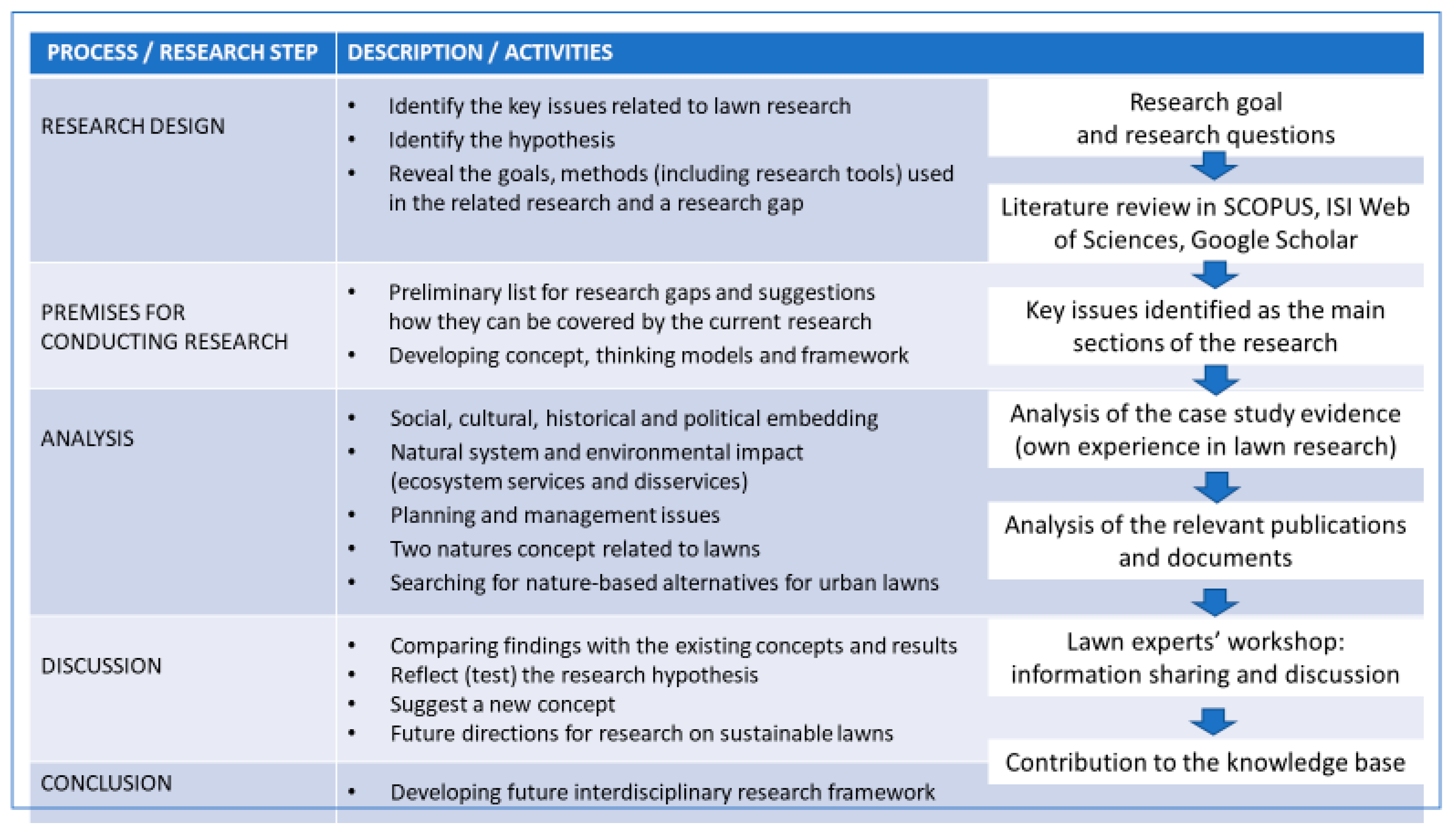
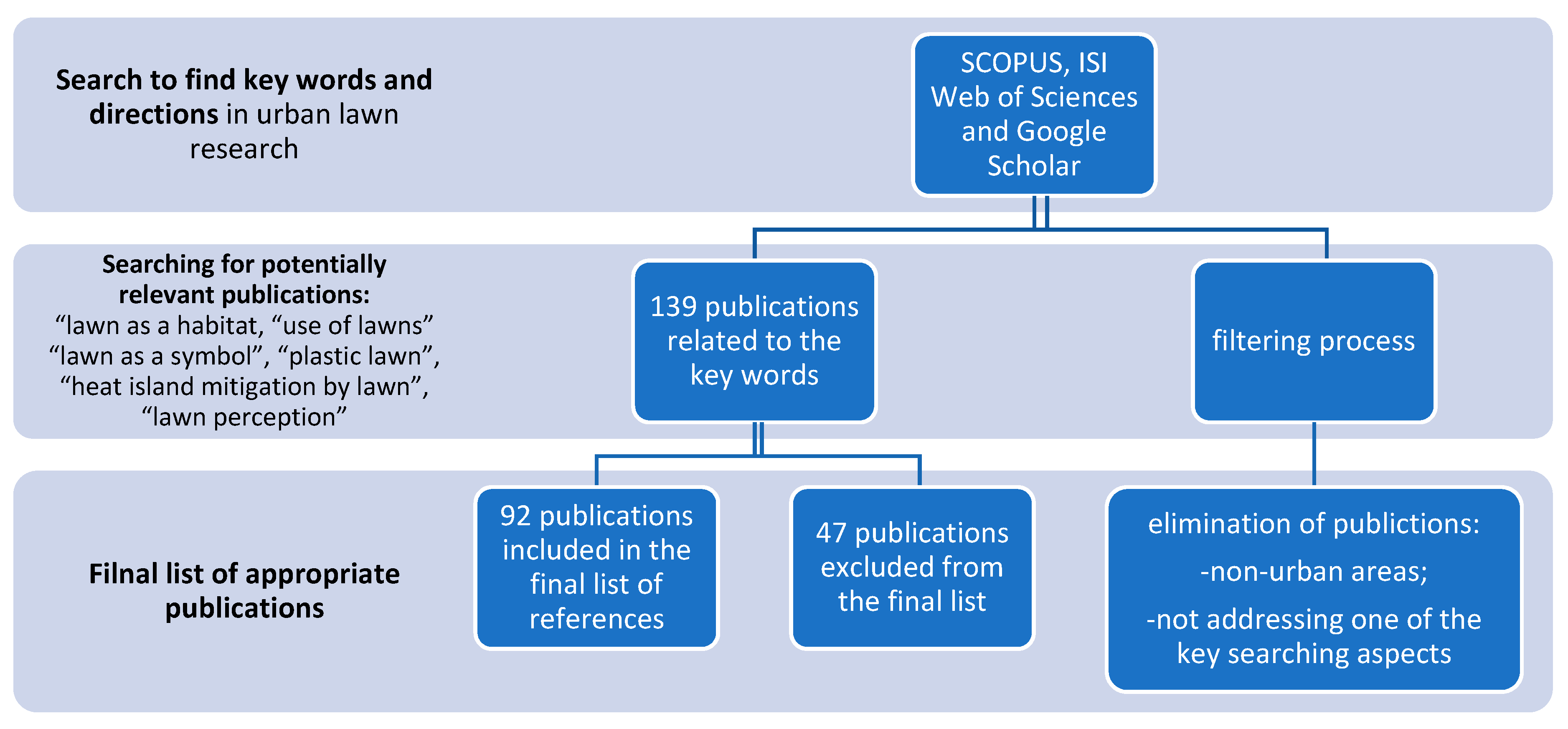

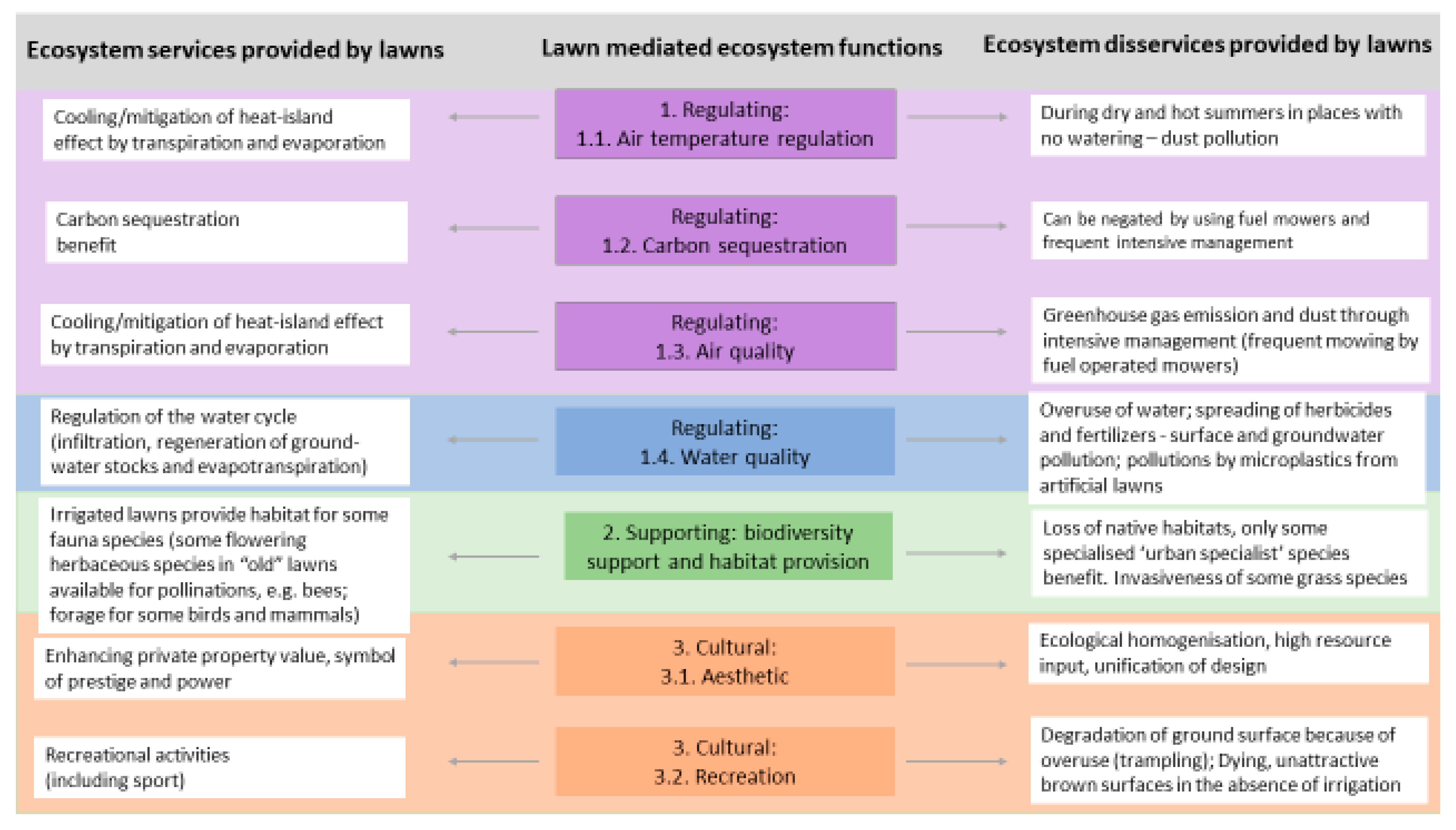




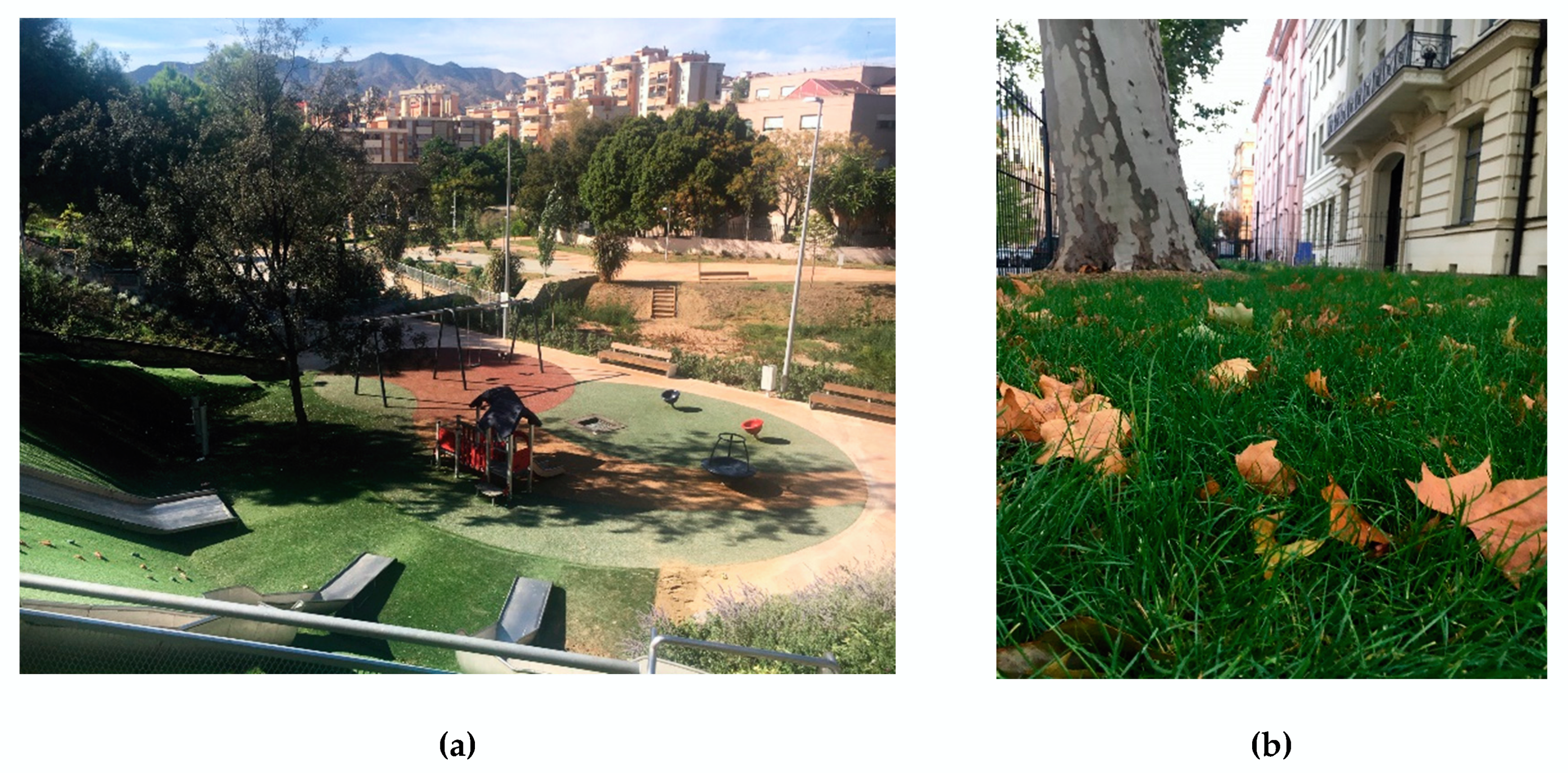

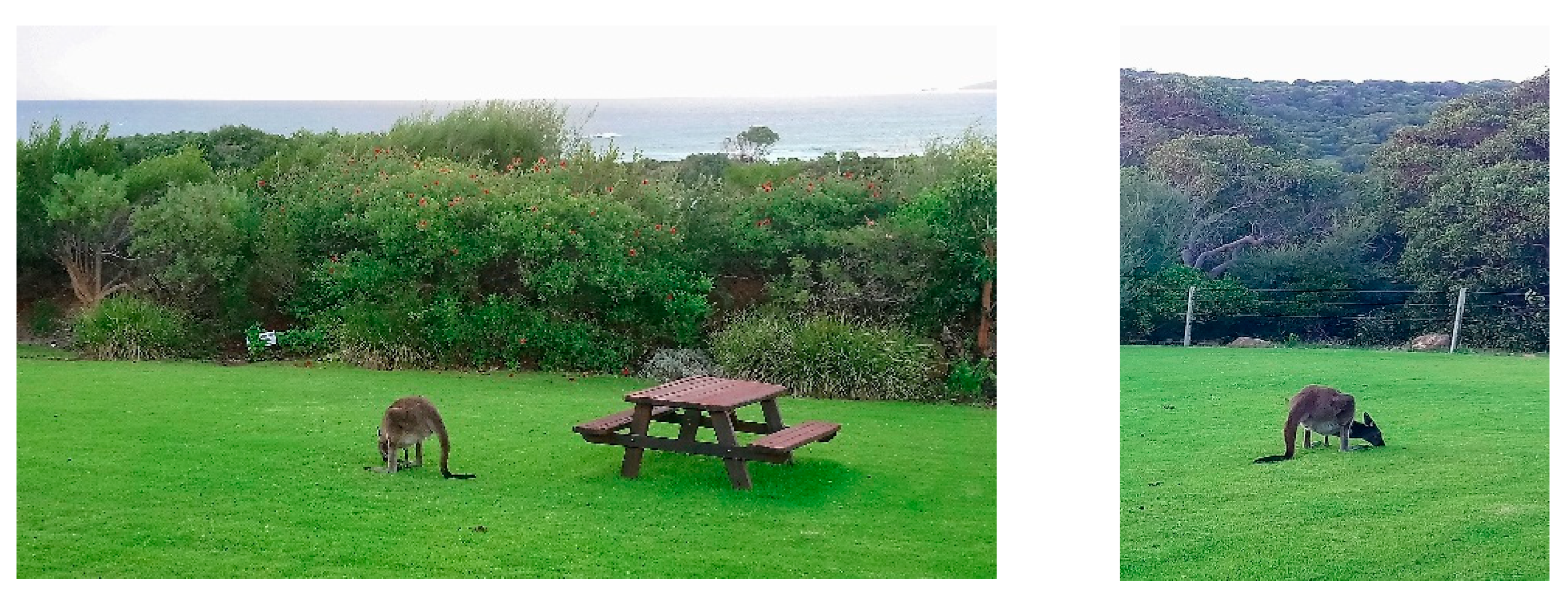
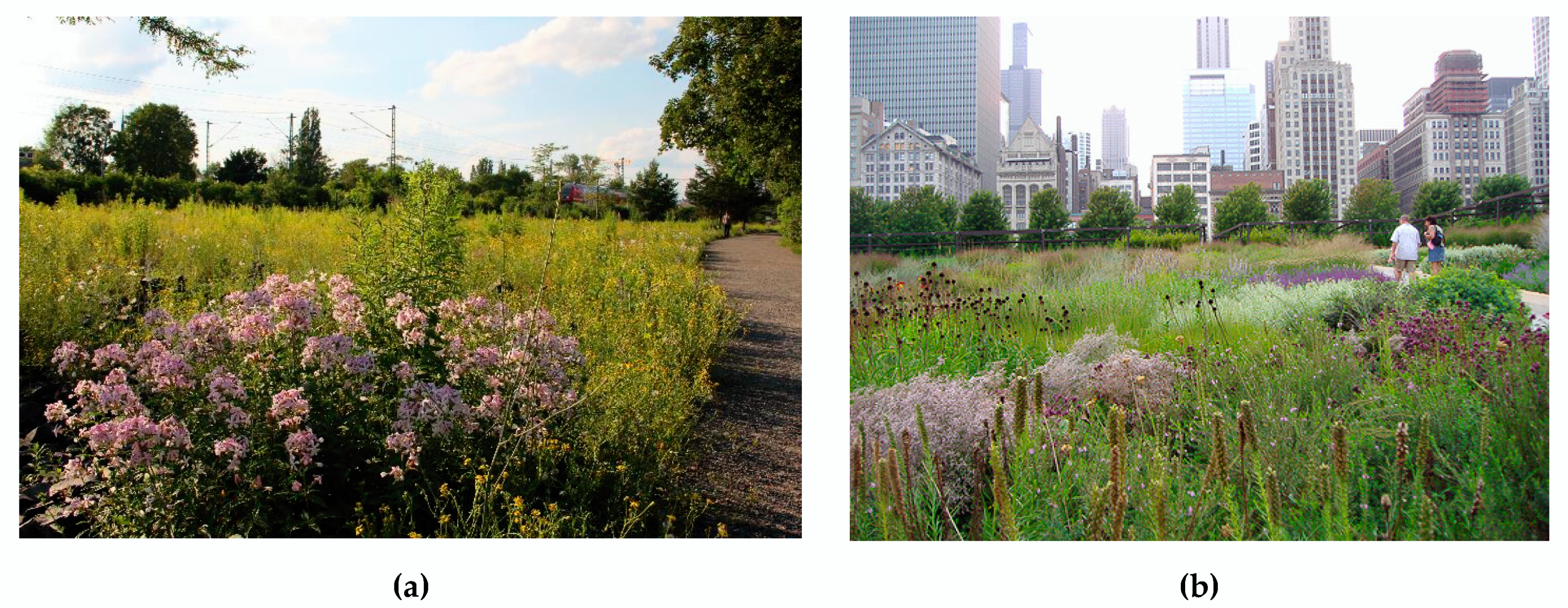


| Category of Research on Lawn | Aspects | References |
|---|---|---|
| Environmental aspects of lawns | Estimation of lawn cover using remote sensing and earth observation methods | Hedblom et al., 2017 [3]; Milesi et al., 2005 [24]; Robbins and Birkenholz, 2003 [25] |
| Biodiversity and vegetation aspects | Gaston et al., 2005 [26]; Hahs and McDonnell, 2007 [27]; Lindenmayer et al., 2008 [28]; Müller, 1990 [29]; Stewart et al., 2009 [30]; Sukopp and Kowarik, 1990 [31]; Threlfall et.al., 2015 [32] | |
| Ecosystem services provided by lawns | Amani-Beni et al., 2018 [33]; Armson et al., 2013 [34]; Beard and Green, 1994 [35]; Brunton et al., 2010 [36]; Burgin, 2016 [37]; Cumming, 2018 [6]; Fischer et al., 2013 [38]; Fischer et al., 2016 [39]; Haase et al., 2014a [7]; Haase et al., 2014b [8]; Johnson, 2013 [40]; Lele et al., 2013 [41]; Monteiro, 2017 [42]; Stirling et al., 2013 [43]; Thompson and Kao-Kniffin, 2017 [5]; Trigger and Mulcock, 2005 [44]; Wang et al., 2016 [45]; Wastian et al., 2004 [46] | |
| Ecosystem disservices provided by lawns: | Brunton et al., 2010 [36]; Burgin, 2016 [37]; Campagne et al., 2018 [47]; Cumming, 2018 [6]; Döhren and Haase, 2015 [48]; Dunn, 2010 [49]; Ignatieva and Hedblom, 2018 [1]; Lyytimäki, 2013 [50]; McKinney, 2006 [12]; Milesi et al., 2005 [24]; Müller and Sukopp, 2016 [51]; Priest et al., 2000 [52]; Runola et al., 2013 [53]; Shackleton et al., 2016 [54]; Schapel et al., 2018 [55]; Sharma et al., 1996 [56]; Stirling et al., 2013 [43]; Trigger and Mulcock, 2005 [44]; Wheeler et al., 2017 [13] | |
| Social aspects of lawns | Public perception, attitude and preferences | Elgizawy, 2016 [57]; Han et al., 2013 [58]; Ignatieva, 2017 [22]; Jenkins, 1994 [59]; Pisa, 2019 [60]; Poškus and Poškienė, 2015 [61]; Rall et al., 2017 [62]; Ramer et al., 2019 [63]; Robbins, 2007 [64]; Sewel et al., 2017 [65]; Teysott, 1999 [66]; Müller, 1990 [29]; Trigger and Mulcock, 2005 [44]; Yang et al., 2019 [4,67] |
| Urbanisation and homogenisation | Antrop, 2004 [68]; Groffman et al., 2014 [11]; Ignatieva and Hedblom, 2018 [1]; Pondichie, 2012 [69] | |
| Health and well-being aspects | Elgizawy, 2016 [57]; Payne and Bruce, 2019 [70]; Stolz et al., 2018 [71] | |
| History of lawns | History of development | Ignatieva, 2017 [22]; Ignatieva, 2018 [72]; Ignatieva and Hedblom, 2018 [1]; Fischer et al., 2013 [38]; Gaynor, 2017 [73]; Hipple, 1957 [74]; Jenkins, 1994 [59]; Robins, 2007 [64]; Robinson, 1991 [75]; Yang et al., 2019 [4,67] |
| Lawn as a site of conflicts | Greenbaum, 2000 [76]; Harari, 2016 [77]; Trudgill et al., 2010 [78] | |
| Lawn alternatives | Searching for lawn’s alternatives and sustainable lawn management | Alumai, 2008 [79]; Burgin, 2016 [37]; Chawla et al., 2018 [80]; Cumming, 2018 [6]; Gaynor, 2017 [73]; Hogue and Pinceti, 2015 [16]; Ignatieva et. al., 2008 [23]; Ignatieva, 2010 [81]; Ignatieva and Ahrné, 2013 [82]; Johnson, 2013 [40]; Pineo and Barton, 2010 [83]; Schapel et al., 2018 [55]; Steinberg, 2006 [84]; Teysott, 1999 [66]; Wasowski and Wasowski, 2002 [85]; Wasowski and Wasowski, 2004 [86]; Wastian et al., 2004 [46]; Wilson and Feuch, 2018 [87]; Zollner, 2018 [88] |
| Alternative to lawns | Bormann et al., 2001 [89]; Daniels, 1995 [90]; Hitchmough, 2004 [91]; Ignatieva, 2017 [22]; Ignatieva, 2018 [72]; Ignatieva and Hedblom, 2018 [1]; Robinson, 1991 [75]; Sprajcar, 2017 [92] | |
| Artificial lawn related aspects | Brooks and Francis, 2019 [93]; Chawla et al., 2018 [80]; Fleming et al., 2013 [18]; Kaminski, 2019 [19]; Loveday et al., 2019 [94] | |
| Two natures | Novel and designed ecosystems | Higgs, 2017 [95]; Hobbs et al., 2006 [96]; Kowarik, 2011 [97] |
| Europe | Australia and New Zealand |
|---|---|
| Urban nature: no separation of native and non-native components | Urban nature means native ecosystems |
| Urban biodiversity: all components including remnants of native vegetation (if any), semi-natural, spontaneously appearing and planted exotic plant species | Separation of man-made (designed) nature from native ecosystems (native nature). New Zealand even introduced a separate term: native biodiversity |
| Small percentage of naturalised and invasive species | Large percentage of invasive and naturalised species as well as introduced species |
| Europe is the birthplace of the urban nature vision (landscape architecture styles) | Receiver of European nature vision: “beautiful” green nature |
| More relaxed attitude towards native/exotic approach | Urban green infrastructure, connectivity of green corridors, water sensitive design, protection means conservation, restoration and connectivity of remnants of native vegetation |
| Europe as the “cradle” of urban ecology science | Very few studies of “designed nature” lawns, private gardens, post-industrial zones, wastelands, road vegetation, etc., and their ecosystem services and potential for sustainable design principles |
| Elaborated methodology of urban ecology research (flora, vegetation and their related urban ecology aspects, social perceptions), including ecosystem service flows of benefits | Very little research into urban soil characteristics, ecosystem services provision, trample resistance and stability, social acceptance and preferences and constraints among different users |
| Alternatives to Lawns | Germany | Sweden | UK | a USA | b USA | Australia | New Zealand |
|---|---|---|---|---|---|---|---|
| Go Spontaneous | + | ||||||
| Meadows | + | + | + | ||||
| Grass-free (tapestry lawns) | + | + | |||||
| Pictorial meadows | + | + | + | + | + (road plantings) | ||
| Naturalistic plantings | + | ||||||
| Prairie gardens | + | ||||||
| Swale and rain gardens plantings | + | + | + | + | + | + | + |
| Xeriscape gardens/rock gardens | + | + | + | ||||
| Verge gardens and woody meadows | + | ||||||
| Use of appropriate native groundcovers in private gardens | + | + | + | + | + | + | + |
| Urban Planning | Landscape Design | Ecological Design | Maintenance Approach |
|---|---|---|---|
| Reduce conventional lawns by sustainable planning of green areas and green infrastructure and new design styles | Rethink spatial composition (avoid the homogenous mono-species approach), choice of appropriate, site-related plants | Mimic spatial structure and composition of existing resistant biodiverse lawns and surrounding native ecosystems that can be used as inspiration | Self-sustaining system, locally driven (climate, culture and economic appropriateness) cutting the regime approach by reinforcing local biodiversity. Sustainable management (appropriate soil preparation, appropriate mowing regime, use of electric or robotic mowers and smart irrigation schemes) |
© 2020 by the authors. Licensee MDPI, Basel, Switzerland. This article is an open access article distributed under the terms and conditions of the Creative Commons Attribution (CC BY) license (http://creativecommons.org/licenses/by/4.0/).
Share and Cite
Ignatieva, M.; Haase, D.; Dushkova, D.; Haase, A. Lawns in Cities: From a Globalised Urban Green Space Phenomenon to Sustainable Nature-Based Solutions. Land 2020, 9, 73. https://doi.org/10.3390/land9030073
Ignatieva M, Haase D, Dushkova D, Haase A. Lawns in Cities: From a Globalised Urban Green Space Phenomenon to Sustainable Nature-Based Solutions. Land. 2020; 9(3):73. https://doi.org/10.3390/land9030073
Chicago/Turabian StyleIgnatieva, Maria, Dagmar Haase, Diana Dushkova, and Annegret Haase. 2020. "Lawns in Cities: From a Globalised Urban Green Space Phenomenon to Sustainable Nature-Based Solutions" Land 9, no. 3: 73. https://doi.org/10.3390/land9030073
APA StyleIgnatieva, M., Haase, D., Dushkova, D., & Haase, A. (2020). Lawns in Cities: From a Globalised Urban Green Space Phenomenon to Sustainable Nature-Based Solutions. Land, 9(3), 73. https://doi.org/10.3390/land9030073








